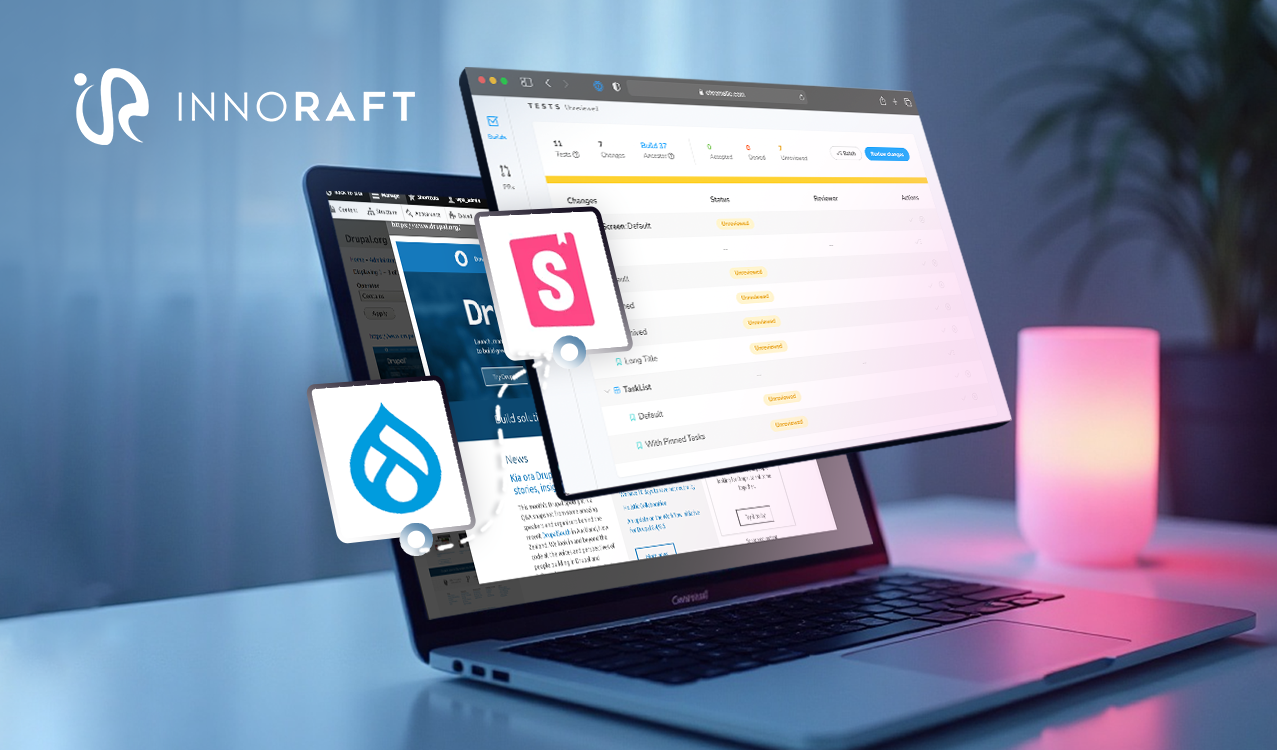As digital products grow, keeping them scalable and easy to use becomes more challenging. One of the biggest hurdles is maintaining a consistent user interface. Without a clear system in place, you end up with mismatched buttons, awkward navigation, inconsistent fonts, and misaligned elements. These might seem like small issues, but they can frustrate users, make your product feel unreliable, and even hurt engagement and conversions.
For developers, UI inconsistencies mean wasted time rebuilding similar components, slower workflows, and messy code that's hard to maintain. That's where design systems come in. A design system is a toolkit of reusable components, design guidelines, and best practices. It helps teams work faster and keeps the look and feel of the product consistent as it grows.
At the heart of many design systems is the component library—where design rules are turned into real reusable code. This is where Storybook, a robust front-end workshop environment tool can help. When you create scalable UI design with Storybook , you can leverage an isolated development environment for building and testing UI components. It works like a workshop where you can build, fine-tune, and document the parts of your digital product interface, making it easier to build and offer a consistent user experience.
What is Storybook?
Storybook is an open-source tool that gives developers a dedicated space to build and test UI components on their own—without the distractions of the rest of the application. Think of it as a workshop where you can design and fine-tune each piece of your interface in isolation. Choosing component-driven development with Storybook can help your development team focus on how a component looks and behaves without worrying about data, routing, or other parts of your app.
At the heart of building reusable UI components in Storybook are stories—small examples that show how a component looks in different situations. For instance, a button might have stories for its default, hover, disabled, loading, or icon versions. Each story defines the props and data needed to show that specific version, making it quick and easy to preview. This setup removes the hassle of recreating complicated app states just to see how one component works. Developers can quickly test, tweak, and document components, ensuring they work as expected across different use cases.
Storybook isn't just for building—it also helps document and test components, making it a key part of any modern front-end workflow. Next, we'll take a closer look at the features that make Storybook such a powerful tool.
Story Browser
One of Storybook’s most user-friendly features is the Story Browser. It gives developers a simple sidebar-and-canvas layout to explore and interact with UI components. The sidebar lays out components in a nested hierarchical order, making it easy to find a specific component or one of its variations. When you click on a story, the component appears in the main preview area—completely isolated from the rest of the app.
This feature ensures that there’s no need to run the full application or jump through hoops to reach a certain UI state. You can view and test components instantly, one at a time. It’s a huge time-saver and helps ensure that each part of your interface works just the way it should.
For large projects, the Story Browser’s ability to group and categorize components becomes especially valuable, helping teams stay organized as the design system grows, and helping to maintain a component-driven development process.
Addons
Storybook’s addon system lets you extend its features and tailor it to your team’s workflow. Addons are like plugins—they add extra tools that help with building, testing, and documenting components more efficiently.
Here are a few popular examples:
- Docs: Automatically generates documentation for components, so your team always has clear, up-to-date references.
- Accessibility: Tools like Axe help check components for accessibility issues.
There are hundreds of Storybook addons for accessibility and testing, covering everything from logging user actions to simulating mobile environments. With the right set of addons, Storybook becomes an even more powerful and flexible tool for front-end development.
Customization
Storybook gives developers a lot of flexibility to make stories more interactive, useful, and realistic. Here are some of the key ways you can customize your stories during component-driven development with Storybook:
- Args: These let you change a component’s props dynamically, so you can create different versions of a component without writing separate code for each one.
- Parameters: Add extra information to stories or control how addons behave—for example, setting a default background color or adjusting the viewport size.
- Decorators: Wrap components with extra context, like themes or layout wrappers. This is helpful for simulating how a component looks and works within the actual app environment.
- Controls: Let you adjust component props on the fly and instantly see the results.
- Viewports: Preview how components look on different screen sizes and devices.
- Addons: As mentioned earlier, these plug into your stories to add things like interactivity, accessibility checks, or documentation.
Together, these tools help you build stories that don’t just show what a component looks like—but how it behaves in different scenarios.
Documentation
Storybook acts as a central hub for all your UI components—bringing together code, examples, and documentation in one place. Each story shows a specific version of a component, including the props it uses and how it should behave. This setup makes it easy for teams to understand, test, and reuse components without guesswork.
The Docs addon takes it further by allowing you to create rich, customizable documentation. You can write with Markdown, include live component examples, and organize everything into clear, structured pages. Storybook documentation for UI components ensures that everyone—developers, designers, and even non-technical team members—can access accurate, up-to-date details about the UI.
Testing
Storybook makes it easier to test UI components by focusing on them one at a time, outside the full application. This approach helps catch issues early and ensures each component works as expected. Here’s how Storybook supports testing:
- Manual spot checks: You can quickly review components by browsing their stories and checking how they look and behave.
- Automated testing: Storybook works with tools like Jest, Vitest, and Testing Library. You can even reuse stories as test cases, keeping things consistent between development and testing.
- Visual testing with Storybook: Visual and regression testing of the UI is supported with tools like Chromatic that track visual changes over time, so you can catch unintended design shifts before they reach production.
- Accessibility checks: Storybook addons for accessibility and testing, such as Axe, help flag accessibility issues and suggest improvements.
By isolating components and testing each variation, Storybook helps you cover more ground and reduce the chances of bugs slipping through.
Publishing and Collaboration
Scalable UI design with Storybook makes it simple to share UI components with your team and stakeholders. Developers can publish Storybook as a static website, giving everyone a chance to review and provide feedback—no access to the codebase required. This is especially helpful for:
- Designers: To ensure components match the original design specs.
- Product Managers: To review UI changes and give their approval.
- QA Teams: To test components in isolation before they’re added to the main app.
Storybook also allows you to embed stories into wikis, Markdown files, and design tools like Figma, making collaboration smoother and keeping everyone on the same page about the UI’s current state.
Reusability
Storybook’s Component Story Format (CSF) is based on ES6 modules, which makes it easy to create reusable UI components in Storybook for different tools and workflows. Here are a few examples:
- Testing: You can import stories into testing tools like Jest or Vitest to check component interactions.
- Visual Testing: Use stories with tools like Chromatic for visual regression testing.
- User Flow Testing: Integrate stories with tools like Playwright or Cypress to test end-to-end user interactions.
This reusability makes it easier to avoid vendor lock-in and ensures that stories can be used throughout the entire development process.
CI/CD Integrations
Storybook for UI component libraries integrates smoothly with continuous integration and delivery (CI/CD) pipelines, automating key tasks like:
- UI Testing: Run tests to ensure components behave as expected.
- Visual Regression Testing: Catch unintended changes in the UI’s appearance.
- Accessibility Audits: Make sure components meet accessibility standards.
- Documentation Updates: Automatically generate and publish updated documentation.
This integration reduces manual work and ensures that UI components are thoroughly tested and documented before being deployed to production.
With its powerful features, Storybook is essential for modern UI development. The focused environment for building, testing, and documenting components, help developers create durable, well-documented, and scalable UI design with Storybook. Its flexibility and integration options make it the perfect tool for projects of all sizes—from small teams to large enterprises.
Why Choose Storybook?
Storybook tackles many of the challenges that come with maintaining UI consistency and building complex interfaces. The benefits of Storybook in front-end development go beyond just development—it improves collaboration, speeds up workflows, enhances testing, and ensures high-quality documentation.
- Faster Development: Storybook speeds up the development process by allowing developers to build and test components in isolation, without needing to spin up the whole application.
- Better Collaboration: With Storybook for UI component libraries it is easier for designers, developers, and product managers to work together. Designers get interactive previews, developers understand how to implement components, and stakeholders can review them without needing technical setup.
- Improved UI Quality and Consistency: Building components in isolation helps ensure higher quality. Storybook’s documentation and visual previews keep everything consistent across the app, reducing design drift and UI bugs. It also supports various testing methods, catching issues earlier in the development process.
- Simplified Maintenance and Refactoring: Isolated, well-documented components are easier to update and maintain, reducing the risk of causing unintended issues when changes are made.
- Reusable UI components in Storybook: By showcasing components and their variations, Storybook encourages developers to reuse existing components instead of creating new ones from scratch, saving time and maintaining consistency.
- Living Documentation: With addons like auto-docs, Storybook auto-generates documentation that stays up-to-date with your components. This living documentation is invaluable for on-boarding new team members and serves as a reliable reference for everyone.
- Better Design System Adoption: For teams building and maintaining design systems, Storybook is the perfect tool to document, showcase, and distribute components, helping drive consistent adoption across projects.
Conclusion: Unlocking Scalable Design with Storybook
Maintaining UI consistency in complex digital products can be a major challenge but Storybook help tackle these issues. The design system tool provides a dedicated environment for building, testing, and documenting UI components in isolation. It allows developers to focus on individual components, while also improving collaboration between designers and developers with a shared visual interface. Storybook supports comprehensive testing (visual, interaction, accessibility) and auto-generates documentation, keeping everything in sync with the codebase.
Adopting Storybook is more than just adding a tool to your workflow—it’s a strategic move to build scalable, maintainable, and consistent user interfaces. By enhancing development speed, team collaboration, and quality checks, Storybook helps teams deliver scalable UI design with Storybook and better digital products faster. It also aligns development practices with industry trends, setting the stage for long-term success in the ever-evolving world of web development. In the end, Storybook unlocks the potential for truly scalable and high-quality UI design.

